C.E. Flores's Blog, page 54
August 27, 2018
Move to Mexico Now eCourse
While I know many of you already are living full, rich and diverse lives here in Mexico, I suspect that there are a number of you who read my blog in order to learn about life in Mexico before you make the move. I appreciate comments and questions from both groups (and my mom) and of course, wouldn’t find blogging half as interesting without readers.
Today, however, I’d like to highlight something that would be especially helpful to those of you who have yet to follow your bliss to Mexico. The Move to Mexico Now eCourse. Because who doesn’t want to live in Mexico?
There are things you should do before moving, like opening an online bank account, divesting yourself of most of the crap you’ve been hoarding and getting your pets ready for travel. But even before you tackle all those, you should create a life plan. I know, sometimes life has a different plan and doesn’t give you enough time to figure it all out, but having a detailed life plan BEFORE you make the move to Mexico will go a long way to ensure that all your needs are met, reduce the angst of cultural shock, and help you create a life you love.
I’ve been fortunate enough be allowed to preview this introductory course which opens on August 27 and what I’ve seen makes me rub my hands together in glee. THIS is what I needed when we were packing our bags to come to Mexico. THIS is what I need now to work on those little aspects of my life in Mexico that aren’t living up to my expectations just yet.
I invite you to check out the Move to Mexico eCourse and if it is something you think you’ll benefit from, enroll in the Intro course at the special rate of $29. This rate is only good for a limited time, so don’t wait! The course is self-paced, so you don’t need to worry about getting it finished in a day, but the price is set to increase in September.
****************
[image error]
August 25, 2018
Back to Basics Bundle Flash Sale
I can’t say how much I love these ebook bundles! This is one of my favorites by far. Just look at what you get!
[image error] [image error] [image error] [image error] [image error] [image error] [image error] [image error] [image error] [image error]
This year’s bundle includes over 59 resources to help you get back to basics and will help you:
Cook from scratch using nourishing real food
Plant and harvest your own vegetables
Learn what it means to live a simpler life without stress
Create a wholesome, healthy food storage
Learn how to create and use natural remedies
Plus learn how to live a more frugal life, do more things yourself, manage a small homestead, and much much more!
If you were to buy each of these resources separately you’d pay over $500, but for this short sale it’s 92% off!
The bundle is only available for a few days: August 25 – 27
Click here to find out more! I know you won’t be disappointed! I sure wasn’t!
***********************
[image error]
August 23, 2018
Alcohol and Mexico–like oil and water
The first alcoholic beverages in Mexico were created from the agave plant which is the source of tequila, mezcal, raicilla, bacanora, comiteco, curado, Licor de henequén, and pulque.
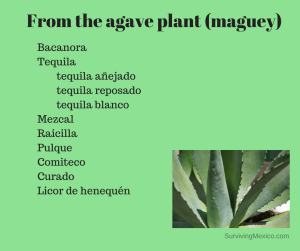
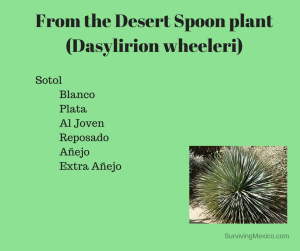
The story goes that the creation of the maguey (agave) plant was the result of the ill-fated love between Mayahuel, a goddess of fertility and Quetzalcóatl. Mayahuel’s busybody abuelita (grandmother) sought to separate the lovers so Mayahuel and Quetzalcóatl transformed themselves into a single tree with two branches. Granny sliced Mayahuel’s branch into many small pieces which Quetzalcóatl buried, weeping copious tears. From Mayahuel’s remains, the maguey plant was born. When the plant matures, the sweep sap (aguamiel) that seeps from the center is said to be the remnants of the tears shed by Quetzalcóatl.
Unfermented aguamiel known as octli was given to the elderly, sick and women after childbirth and used as a ceremonial drink for the entire family including babies and children on certain occasions. The fermented aguamiel (octli poliuhqui) was used to treat depression and given to dull the pain before ceremonial sacrifices. The recipe for the alcoholic octli poliuhqui (now known as pulque) was given to humans by Patécatl who was married to Mayahuel.
Patécatl and Mayahuel had 400 children known as the Los Centzon Totochtin. These 400 minor deities de los borrachos (drunks) were associated with dreams and awakening, confusion and lucidity, and death. Their birth gave Mayahuel a holy duality. Not only was she a goddess of fertility and the earth with multiple breasts to nourish her many children, but also with the creation of pulque and her love for Quetzalcóatl, she became associated with drunkenness and adultery. Her influence was so great that one day of every month was devoted to her and children born on that day were destined to become drunks or commit adultery (probably while drunk).
Understanding the strength of the fermented aguamiel, excessive drinking was prohibited. In fact, public drunkenness was punishable by death unless you were over the age of 70.

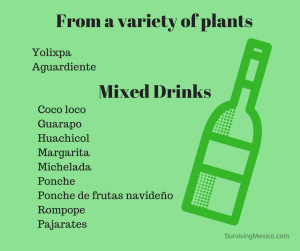
Not content with the local inebriants, Spanish conquerors imported plants from their native land and found that the climate and soil composition were an ideal environment to grow grapes.
Several areas were already known for their cultivation and fermentation of wild grades. The Mexicas called alcohol made from wild grapes acacholli. The Purépechas referred to it as seruráni. The Otomíes used the term obxi and to the Tarahumaras it was known asúri.
[image error]
Vineyards outside of San Miguel de Allende
After the Spanish conquest, Hernán Cortés had seeds brought from Cuba from plants originally brought from Spain for wine production in Mexico. In 1524, he decreed that Spanish settlers should plant 1000 grape vines for every 100 native servants owned. The first vineyards were established in Huejotzingo and around the conquered Mexico City. This hybrid plant was known as xocomecatl in náhuatl and the resulting alcoholic beverage was known as tlapaloctli.
In 1531 the Spanish king Carlos V ordered that emmigrants destined for Mexico settlement take grape vines and olives for cultivation. Converting the indigenous took a back burner to wine production in Metztitlán. The Augustine monks of the area managed to create enough wine to meet local consumption needs and export to Mexico City, which they sent by the wagonload. Not to be outdone, the Jesuit monks in Baja California cultivated grape plants to provide for the thirst of the California missions up and down the coast beginning with San Diego de Alcalá
Thus, vineyards became a profitable enterprise in Mexico post-conquest. This wine producing prosperity continued unchecked until 1595 when King Felipe II prohibited the planting of new vines in the country because the wines being produced in Mexico were of superior quality to wines being produced in Spain which made the Spanish wine producers unhappy.
Even Miguel Hidalgo practiced vitivinicultura in what is now known as Dolores Hidalgo, Guanajuato. Unfortunately, Virrey Francisco Xavier Venegas destroyed his vineyard in retaliation for Hidalgo’s treasonous acts against the Spanish crown during the War for Independence.
Fermented maguey and grape consumption aside, Mexico is the world’s tenth largest beer consumer and the third largest beer producer. There are two main beer producers in Mexico. Cervecería Cuauhtémoc Moctezuma and Grupo Modelo.
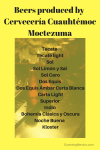


Before the conquest, a variety of beers were produced from fermented corn including Pox, Tejuino, Tepache, tesgüino, and pozol. The first barley based cervecería (brewery) was set up near Mexico City by Alfonso de Herrero in 1543 or 1544. Dark beers became popular under the rule of Maximilian I from Austria. Beer consumption has continued to grow in Mexico. As of 2010, the Mexican average annual beer consumption is 60 liters per adult.
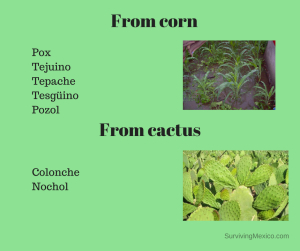

Mexico ranks at the top for alcohol consumption with one of the highest mortality rate for alcoholic liver disease in the world. The prevalence of alcoholic liver disease and addiction is apparently a combination of these pre-conquest traditions and the post-conquest gene mixture.
Each weekend, approximately 30 million Mexicans consume more than 5 drinks per day while another 10 million Mexicans have at least one alcoholic drink daily with about 5 million Mexicans developing a strong alcohol dependence. Regular alcohol consumption begins in early adolescence. One study found that 61.4% of 12-17-year-olds are regular drinkers. In another study, over 1/3 of 12-year-olds in Mexico City admitted to drinking. By age 17, 82.5% have used alcohol. Another study found that Mexican adolescents who drink regularly have more positive beliefs about consumption than those who don’t drink. In part, this is because drinking alcohol during this key period of development of the brain causes permanent alteration of the brain.



Drinking is common at most social or religious events in Mexico including weddings, quinceaneras, and christenings. Although this is a culturally acceptable activity, alcohol dependence grows over time. Ten years after beginning regular alcohol use the number of beers consumed per event typically goes from 4 to 6 to 20-24 beers. Because of this social association with events and heavy alcohol ingestion, binge drinking, infrequent drinking with sporadic heavy drinking, is the most common drinking pattern in Mexico.
So why is this a problem?
Compared to other countries, Mexico has the youngest people with alcoholic cirrhosis in the world with an average age of 23 to 30 years. In part, this is due to the unique set of genes found in the general Mexican population.


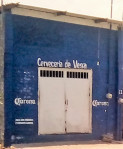
Even after a diagnosis of alcoholic cirrhosis, alcoholics continue to drink themselves to death. 40%-60% of the risk for developing chronic alcoholism is also genetic which is the number one cause of cirrhosis in Mexican males and the fourth-leading cause of death in Mexico.
Not only does excessive alcohol consumption cause life-threatening medical problems for the drinker but there is a high correlation between acts of violence and alcohol use, not that anyone is surprised by that finding. The WHO has reported that in Mexico alcohol plays a part in 51% of injuries resulting from violence and 78% of paralysis and death incidents. These injuries, paralysis, and death are not always confined to the person drinking. Domestic abuse, rape, and femicide come to mind.

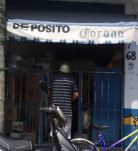

So can those struggling with alcoholism get help?
The Mexican government recognized the growing issue of alcohol dependence among teenagers and young adults in 2000 and introduced NOM 028-SSA-1999 which outlines preventative and treatment measures available. As with most government-sponsored programs, there are a lot of good intentions but very little follow through.
Central Mexicana de Servicios Generales de Alcohólicos Anónimos, A.C. (Alcoholics Anonymous) can be found in most locations throughout the country. Local meeting groups and albergues (in-house detox centers) sponsored by AA are easily located. There are also Al-anon and Ala-teen groups in many areas. (Central Mexicana de Servicios Generales de Los Grupos Familiares Al-Anon A.C)


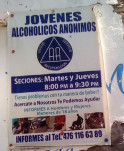
There are psychiatric hospitals (Clínicas) and rehab centers that deal with alcoholism, often at prices the average Mexican can’t afford. A variety of religious groups sponsor retiros (weekend retreats), sometimes free and sometimes at a set cost, as part of rehab programs.
Although with the cards stacked against the typical Mexican with their genetic predisposition for both cirrhosis and alcoholism, long-term recovery by any means is low. On the other hand, there have been promising results using the sage of the diviners’ plant (Salvia divinorum) from the Sierra Madre Oriental region of Oaxaca, Mexico as a treatment for addictions. Salvia effects the dopamine levels in the brain, specifically areas dealing with motivation and reward. More study on its use and applications is needed, however.
August 21, 2018
Just for the ladies
So I’ve discussed healthcare in general, but there are some things ladies need to know to take care of their needs living in Mexico.
[image error]
Family Planning
Mexican health care covers hormonal contraceptives including anticonceptivos hormonales orales/pastillas anticonceptivas (the pill), inyecciones anticonceptivas de aplicación mensual y la trimestral (depo shot monthly or every other month), and los parches anticonceptivos (the patch). It’s also possible to get el dispositivo intrauterino de cobre (DIU) (copper IUD), el dispositivo intrauterino con levonorgestrel (IUD with progestin) and el implante subdérmico (implants).
[image error]Seguro Popular will provide medical instruction on how to use the condón masculino (condom), but you’ll have to get a pack yourself from the pharmacy or your local super (grocery store). Packs are most often behind the counter so you’ll have to ask just like you do for cigarettes, aspirin, and matches. Supposedly, the female condom is also available in some areas, but I have yet to see it where I live.
You can also find douches and pregnancy tests at the pharmacy. And if your man is getting up in years, Cialis and Viagra are available here without a prescription.
Abortion is illegal everywhere in the country except Mexico City, however, you can get the morning after pill (anticoncepción de emergencia/anticoncepción hormonal postcoito).
If you decide you are done having children, you can have your tubes tied with the procedure oclusión tubaria bilateral (OTB) also called salpingoclasia. Believe or not, there is a yearly vasectomy campaign in November and if your male counterpart is willing, he might qualify for a free Vasectomía sin Bisturí (Vasectomy without scalpel). However much vasectomies are promoted, they are still not fully accepted culturally.
Sanitary pads and alternatives
If you aren’t pregnant and Aunt Flo makes her monthly visit, you need to be aware that tampons are hard to find in Mexico. In fact, in some areas, impossible to find. So what’s a lady to do?
Well, there are pads. Most of the pads are wafer thin and scented. Yes, scented. Just like most of the toilet paper. Apparently, Mexico hasn’t made the connection between infections and perfumes in your genital area. So you might want to consider making your own cloth pads. If you aren’t crafty, you can order them online.
Apparently, some version or other of cloth pads have been around for awhile. To say someone is having her period in my husband’s town you say “tiene caballo” which literally means she has a horse but refers to having so much material stuffed between her legs that she is walking bowlegged as if she were riding a horse.
So if the bowlegged trot isn’t for you, you might try a menstrual cup. There are a variety of cups available to accommodate every vagina size. You may need to try a few different types to find something you are comfortable with but I guarantee you, once you find the right fit, you’ll NEVER go back to pads.
If the cup isn’t your cup of tea, you might try period panties or menstrual sponges. I haven’t found either of these options available in stores in my area, but you can find them online. (Check out this discount for Thinx panties)
So there you go ladies. More information that you probably need, but since no one talks about these things locally, you gotta find out from somewhere.
*****************
[image error]
August 20, 2018
Thriving in your Third Act Summit
[image error]
I wasn’t sure I wanted to share this summit with you all. I mean, well, I’m not 50 yet and some of the topics seemed a bit woo-woo even for me. I’m not so sure I want to be a juicy crone quite yet and astrology…well, perhaps not? However, not only is it free, but also some of my favorite authors will be presenting. Take a look at the topics I plan on tuning in for….









If you aren’t able to make the scheduled session, you’ll be able to access the taped version up to 48 hours after. See the full list here. And it’s FREE! You know how I love that!
*************************
[image error]
August 18, 2018
Overview of Travel MedEvac Insurance
Remember I mentioned that travel by ambulance isn’t a free service provided by the Red Cross? When my mother-in-law was in the hospital after being hit by a police officer driving excessively fast for no reason, she was taken to an IMSS hospital since she worked as a street cleaner for the presidencia (town hall). When I arrived, hours after the accident, she had not yet been seen by a doctor, although a nurse had bandaged her leg and taken x-rays. When the doctor finally arrived from Morelia (apparently there wasn’t a doctor on staff), he insisted that she be transported to the Regional Hospital that was better equipped to handle her injuries. The family had to arrange ambulance transportation because she was not in stable enough condition to be moved by other means. Our local Red Cross has the only ambulance in the area. The cost was not covered by IMSS. It took hours to make the arrangements. When she finally arrived at the hospital, she was admitted to ICU. Her spleen had been ruptured in the accident and she was bleeding internally.
The admitting doctor suggested she be transported to the hospital in Leon, GTO, a 4-hour drive. Again, there was the issue of ambulance transport to arrange. For some reason, the family member in charge would not sign off the transfer. My mother-in-law contracted a respiratory infection in the hospital and died.
So believe me when I say that the universal health care Mexico provides through Seguro Popular and IMSS may not be enough in some situations.
Today I’d like to highlight one insurance company’s policies for US and Canadian citizens while they are in Mexico in order to provide a baseline of what type of coverage to look for when purchasing additional insurance.[image error]
Travel MedEvac Insurance’s slogan is Medical Transport Home when the Unexpected Happens (which of course, nobody hopes for but unfortunately is a possibility).
The MedEvac insurance covers evacuation by air transport to a hospital of your choice in your home country (US or Canada) and transfer by air or ambulance to another hospital in Mexico as needed if you are medically unable to travel internationally. So in the event of injury or illness, MedEvac will make sure you are taken to a hospital, whether in Canada, US, or Mexico, that will be able to treat your condition. This is especially helpful if you are in a rural area in Mexico where the medical facilities are understaffed and lacking updated (or even functioning) equipment.
What about your family? Well, MedEvac offers transportation for a traveling companion, spouse, and dependents to the hospital where you been evacuated in your home country. If you are unable to be air-lifted out of Mexico, MedEvac provides transportation for your immediate family to the hospital where you are receiving treatment.
What about your stuff? MedEvac will transport your vehicle, RV, motorcycle, and watercraft from Mexico to your home country. If you are discharged but not able to drive, MedEvac will make sure your vehicle is returned to you in your home country.
What happens if you die? MedEvac will prepare your body for transport and complete the repatriation process up to $50,000 USD. This may include embalming or cremation, casket, and transportation.
So what are your options?
MedEvac offers daily and annual plans. Daily plans are good for up to 90 days in Mexico and best for vacationers, cruisers, business travelers, students, missionaries, church groups, timeshare owners, and volunteers who do not plan on staying more than 90 days in Mexico. There are plans available for groups of 10 with additional plans in increments of 10 at special group rates.
Annual plans are offered for both 6 month and 12 month periods. The Classic Plan covers you if you travel to Mexico several times a year but never longer than 90 days. The Extended-Stay Plan covers you if you live in Mexico part of the year but do not stay longer than the 180-day tourist visa limit. Either plan would work for Snowbirds and frequent travelers.
As of April 2018, a third policy has been added to MedEvac’s plans specially designed for expatriates that live in Mexico more than 180 days per year. In this situation, medical evacuation could include transfer to another hospital for treatment in Mexico rather than in your original country. If your stay is more than 2 days, traveling companions and dependents will be given transportation to their homes. If you are in the hospital for more than 7 days, MedEvac will provide for the transportation of a visitor for a single visit to your bedside.
There are some things to consider.
If you are older than 84 or have been advised by your doctor that you should not travel, you would not qualify for this type of insurance. It’s also important that your passport be current, otherwise, there may be complications in leaving Mexico or entering your home country.
Additionally, there are some situations where accident or injury would not be covered under MedEvac’s policies. If injuries are self-inflicted or sustained in a war zone, you wouldn’t be eligible. If you are injured while piloting your own plane or canyoneering, you wouldn’t be eligible. If you are traveling specifically to seek treatment whether or not medically necessary, you would not qualify for the plans above. (I’ll talk about Medical Tourism in another post.)
There are also some restrictions which you might need to take into consideration when living or traveling in Mexico. You might not be able to be evacuated from areas which the U.S. government has issued travel restrictions (See U. S. Travel Restrictions for Mexico) or areas where civil unrest or natural disaster has temporarily shut down air traffic.
So, as part of a comprehensive medical insurance program, travel insurance, like the policies offered by MedEvac might be something you should seriously consider.
This information is provided for informational purposes only. Please refer to the MedEvac’s page for current plans and prices, requirements and restrictions.[image error]
************************
[image error]
August 16, 2018
Alternative Medical Practitioners in Mexico
[image error]
The indigenous people of Mexico believe that for every physical ailment there is both a physical and spiritual cure. Both must be treated for a full recovery. That belief is the primary reason that curanderos still exist in Mexico today.
The general term curandero (coming from the same root word as the English cure) can be used to refer to a variety of specialties, although these often overlap. The nature of the illness or condition determines which specialist should be consulted.
Yerberos are primarily herbalists. They may prescribe certain herbal remedies to aid in healing. Within this classification are several specialty groups. Yerberos who work primarily with tobacco are known as tabaqueros. Those who work primarily with ayahuasca are known as ayahuasqueros. Yerberos who work with peyote are known as peyoteros.
Hueseros are bone and muscle therapists who treat physical ailments. Sobadores are massagers. Either may be recommended for pregnancy complications such as breech positioning especially in areas where there are limited medical facilities. My father-in-law had several sessions with a sobador after he was hit by a truck on his bicycle to help alleviate lower back pain.
Parteras are midwives and have long held positions of respect in the community. A partera is often a skilled sobadera, huesera and yerbera as well.
Oracionistas work primarily through the power of prayer. Don’t be surprised if the oracionista calls upon the assistance of certain saints or the Virgen de Guadalupe herself. The curandera that I met with was a devout Catholic.
Brujos are witches. They deal in spellwork, the casting or removing of curses. Brujería (witchcraft) has been determined to be illegal in Mexico since 2010 however brujas and brujos abound. In this category are the hechiceros (sorcerers) and santeros. In fact, so popular is witchcraft in Mexico that there are even tourist attractions and markets centered around brujería for those so inclined.
As with any profession, there are levels of competence and experience. It’s also good to keep in mind that some may be complete quacks. My father-in-law went to a curandero in town who told him that he had a parasitic growth in his stomach and that he would need to pay $30,000 pesos to have it removed otherwise he would die. He went to the clinic for confirmation before forking over that huge amount of cash. The lab results showed a stomach virus, nothing more.
Have you met with any alternative medical practitioners in Mexico?
August 13, 2018
A Little about Healthcare in Mexico
Navigating the healthcare system in Mexico isn’t easy. The US embassy even has a page or two available for hospitalized citizens in Mexico and a list of Air Medical Evacuation Services if needed in the worse case scenario. However, with a few bits of information and a little practice, you’ll be sailing through these high changeable medical seas in no time.[image error] The good news is that Mexico has universal health care which is divided into three categories. Seguro Popular is for residents without formal employment. IMSS (Instituto Mexicano del Seguro Social) is provided by employers. ISSTE (Instituto de Seguridad y Servicios Sociales de los Trabajadores del Estado) is only for government workers. Even as a foreigner, you may be eligible for coverage under one of these three setups.
[image error]
This is where you apply for Seguro Popular in our town.
Here’s How to apply for Seguro Popular:The head of the household should take an official id (INE, passport, driver’s license) to the affiliation office which you can find by entering your state and municipal here. If you are not a Mexican citizen, you can use your temporary or permanent residency card. You will need to present a comprobante de domicilio reciente (proof of residency such as electric bill, phone bill or predial). If you live in an area with a population less than 250 residents, you can ask for a letter from the local authorities to verify your address. In our area, this letter can be requested from an office in the presidencia (town hall). You will also need the CURP (Clave Única de Registro de Población) for each member of the family. If including an unmarried son or daughter between the ages of 18 and 25, you will need to present a comprobante de estudios (proof that he or she is a student). If you are renewing your policy, you must present the expired policy. [image error]You’ll get a sheet with a barcode on it. Keep this, it’s your póliza (policy). You’ll need it for every transaction. I’ve seen some people laminate their policy but just slipping it into a plastic sleeve should do the job. The policy has the expiration date, family members covered and whether there is a co-pay or not. No contributiva (non-contributive) means there is no co-pay for most treatments. You might also get a little booklet that lists what Seguro Popular will cover. It’s helpful but there seem to be yearly changes so your booklet might not be up to date. When you go for appointments, take the policy, your CURP (which also has a barcode) and your official ID. [image error]If you do not qualify for coverage under these three groups, you can apply to a private insurance company. This is not a comprehensive list, just a place to start. Check each company’s requirements to see if it would meet your medical needs and if the private medical facilities accept that particular insurance.
AIG
AXA
Allianz
Banorte
BUPA
GNP Grupo Nacional Provincial
Inbursa Inburmedic
Interacciones
La Latinoamericana Seguros
Mapfre Seguros Tepeyac
Met-Life
Pan-American
Plan Seguro
Seguros Atlas
Seguros Monterrey
Vitamédica
Zurich
If medical insurance still seems beyond your financial grasp, take heart. Medical procedures in Mexico are often a fraction of the cost when compared to the United States. In fact, the prices on some procedures are so good, a whole tourism industry sprouted up to take advantage of them. And that’s just with major health issues. Most farmacias (pharmacies) have a doctor available for consult for around $40 pesos for minor medical emergencies like colds, stitches, scorpion stings, or a bean up the nose. [image error]So where can you go for treatment? If you live near Mexico City you are in luck. CDMX (Mexico City) has several high-quality hospitals including the Hospital de la Mujer and Hospital Nacional Homeopatío. Several states also boast having a Hospital Regional de Alta Especialidad. There are even three hospitales psiquiátricos in Mexico should you or someone you love need to avail yourself of their services. [image error]If you live in a rural area and you have Seguro Popular, your first stop will be at the hospital comunitario (community hospital). Don’t expect to be able to waltz right in and see a doctor. Head to the information desk and ask what the procedure is. You ought to do this before anyone needs a doctor. Go in for a family checkup. Everyone will get a routine physical and a little booklet to keep track of appointments. More importantly, you’ll be in the system so making an appointment gets just a bit easier.
[image error]
Hospital Regional (General) in Uriangato, Guanajuato
If your condition is more than that hospital comunitario can handle, you’ll be given a referral to the closest hospital regional or general. You’ll need to head there and find out what the procedure is for making appointments as well. You can ask the security guard to send you in the right direction. Odds are you’ll need to head to Archivos (archives) first. Be aware that each department has its own process. There’s one process for seeing the doctor but a different process for getting lab work done. Keep asking until you understand what it is you need to do. Expect this procedure to change. The newest little hoop to jump through at the hospital I go to is to have the head chemist sign off on your prescription before you can pick it up at the pharmacy. Of course, she isn’t always there. In fact, she’s only there about 2 hours in the morning. So getting your prescription filled is just that much harder. [image error]Pharmacies outside of the hospital don’t typically ask for prescriptions. This makes it much easier to avoid the long and tedious process in order to get medication, especially for chronic illnesses. The best approach is to have an empty bottle of the medicine you need and hand it over to the pharmacist. Ask if there is a generic version and you can save even more money. If you aren’t sure, take a list of the generic varieties that you’ve downloaded from the internet with you.
[image error]
Pharmacy with adjoining doctor’s office.
If you aren’t exactly sure what you need, ask the pharmacist to recommend something for the symptoms you describe or go ahead and get a consultation from the doctor next door. Wait time is typically less than 30 minutes. If there’s a long line, it’s not much effort to find another consultorio adjoining a different pharmacy. [image error]Of course, you can always find a private doctor if you have the means. You’ll get more personalized service and I’ve heard some doctors even make house calls. You might even have round-the-clock service via the doctor’s personal cell phone.[image error] Some areas have a Red Cross facility. This might be your best bet if it is a real emergency. There is a paramedic on call at all times and usually an ambulance. Arriving at a hospital in an ambulance will cut through the red tape for admission. However, be aware that the Red Cross is not a charitable organization. There are fees involved for everything, including the ride to the hospital, and you’ll need to pay up front.
Another thing you might not expect is you’ll have to line up your own blood donors if you require surgery even if you aren’t going to get a blood transfusion. If you are in an accident, that requirement might be waived temporarily but know that you will be expected to get a certain amount of “replacement” blood before being released.[image error] If there’s anything I’ve learned in navigation the medical ocean in Mexico it’s that you need to be your own best advocate. That may include getting your own blood work done at private laboratories, doing some intensive research on the internet, translating it into Spanish and handing it to your doctor. Don’t meekly go along with diagnosis or treatments before checking out alternatives and in some cases, the facts. Don’t allow your level of Spanish mastery to interfere with your health. Bring someone to interpret if need be. Being your own advocate won’t make you the most popular patient in the waiting room, but it might just make you the healthiest.
August 6, 2018
Banking in Mexico
Banking has been one of my least favorite activities. That hasn’t changed since moving to Mexico. In fact, I believe I enjoy it even less. All the banks in Moroleon are within a two-block area smack dab in the center of town. Seriously. There is a Bancomer now at the shopping center, but that’s technically in Uriangato, so it doesn’t count.
[image error]At many banks, you can open an account provided you are residing in Mexico legally (and can prove that with proper documentation) and have a proof of address like internet, electric, water, or cable bill called a comprobante de domicilio. If you rent or live in an area where are are no utilities, it’s much, much more difficult to open an account but not impossible. Since La Yacata has no such modernizations, my employer at the school opened an account for me to receive my paychecks using the school address and her own good name to vouch for me. However, since she is the daughter of the owner of Corona, she’s got a bit of clout at the bank that the average person might not have.
Opening an account isn’t easy. There’s a lot of waiting and signing and more waiting and signing. Then there’s going out to get copies because one set is just not enough. Of course, it’s just your luck that the printer has just run out of ink, so you’ll have to wait while someone heads to the store to get more ink. Or perhaps the person needed to verify your information is out sick today, so you’ll have to come back tomorrow. Read about Dos Tortas banking experience here.[image error] Make sure to read the fine print before opening your account. Some banks have minimal initial deposits or none at all. Others charge a hefty fee each month if you drop below the minimum amount required. Some banks only allow you 3 withdrawals per month before charging fees. Others charge for every withdrawal.
Banco Azteca requires you to have your fingerprint digitally read to withdraw money from your account. This was always a problem for my husband because he has calluses on his fingers from work and the digital reader could never read his fingerprint. So the whole taking out of money from the bank teller process was much longer than it needed to be.
[image error]You can find a list of all banks found in Mexico here.
Bank lines are out of this world on the 15th and 30th of every month, when the majority of Mexicans receive their pay. It may be tempting to use the ATM but there are some things to keep in mind before you do.
Always use ATMs that are part of a bank rather than stand-alone ATMs to reduce the chance of your card being cloned. Even then, there’s a possibility your information can be compromised.
All banks charge fees when you use the ATM. If you request a receipt from the ATM, there’s another charge associated with that. Some banks charge even if you are just checking your balance and you don’t request a receipt. As of 2017, the highest ATM fees belonged to Santander, Banorte, Banamex, Banco Multiva and Scotiabank. To reduce fees, try to take out larger sums. However, each bank has its own withdrawal limit and some are quite low in order to force you to pay the withdrawal charge several times. As you muddle your way through the screens on the ATM, be careful to read each section before hitting accept. In order to withdraw money, you need to accept the charge but you are under no obligation to donate to the charity of the month to get access to the money in your account.[image error] We’ve had accounts at Banamex, Bancomer, and Banco Azteca and were not really happy with any of them. The next best thing for a foreigner to do is open a virtual account.
Charles Schwab Bank and Capital One 360 both have very good reviews. I opened an account with Capital One 360 and have been quite pleased. I was able to apply online from Mexico. Then I was able to go through the verification interview using Skype. I had my card sent to my friend’s house in the US who then shipped it via DHL to me here in Mexico. The only problem I had initially was the $20 deposit to activate my account. I could not deposit it via my computer from Mexico, so had my mom write me a check and deposit it via my sister’s computer in the US. It took about 2 weeks for the check to clear. So if you were in the mind to set up a Capital One 360 account, it might be easier to do it before you leave the US.
I was able to associate my Capital One 360 account with my Paypal via a phone call. I can send and receive money with no additional charges to accounts in the US via Zelle. I can have checks direct deposited to my account and withdraw it from any ATM here in Mexico. Right now I have been using the HSBC ATM because it only charges about $33 pesos per transaction. The last time I tried Bancomer, the fee was $80 pesos!
I can use my Capital One 360 account to make purchases at Amazon.com and Amazon.com.mx. Online shopping has never been so easy!
I only use my card at Amazon. I NEVER use my card to buy things in Mexico. We had very negative experiences with our Banco Azteca card. We used it to buy groceries at Soriana and there were several large unexplained purchases made before we caught it. We got a different card and used it to buy gas. Lots more charges were made and we again canceled the card. Even after we had no card, there were charges made to the account at Elektra which we refused to pay. As a result, all our local transactions are cash on the barrel as Charles Ingalls would say.
I’ve never written a check here in Mexico either. People here are suspicious of checks and with good reason. Once, I received a tax refund which was a check. Instead of going to the bank to cash it, I endorsed it over to my husband who took it to a liquor store that changed it for cash for a small fee. I think it was $50 pesos or so. He took the check, my passport, and his ID and voila! Trato hecho![image error]If you happen to have some US currency, you can take it to the bank to exchange it for pesos or to a Casa de Cambio. You might just get a better exchange rate at the Casa de Cambio, so ask around first. It seems like banks are not required to give you up to the moment exchange rates. Neither the banks nor the Casas de Cambio accepts coins in our area, only bills. If you find you have a lot of change, you might want to find someone that is visiting relatives here in Mexico and ask if you can swap your change for some bills.[image error] If you are looking to remodel your house, start a small business, or need a small infusion of moolah, you might want to check out places like the Financiera Popular En Comunidad for microloans with affordable repayments. Each agency has its own list of requisitos (requirements) but often gives better rates than a bank.
So there you have it, my two cents on banking in Mexico.
***************
[image error]
August 2, 2018
Playing Tourist–Dolores Hidalgo, Gto
I’m not a big fan of Mexican movies, but every now and then, one catches my fancy. Our latest tourist adventure was inspired by 2014 movie En El Último Trago. Three old geezers set out on a whirlwind adventure, well, as whirlwind as 3 old geezers can spin, to Dolores Hidalgo, specifically to the José Alfredo Jiménez museum. The movie is a hoot. There was nothing for it but to recreate their journey to Dolores Hidalgo ourselves.
It’s only about 3 hours from our home, so it was an easy day trip. Thank god, we had no vehicle problems or no random police stops. Nearly all of my proposed visit sites were clustered near the centro, so we parked and hoofed it.
After stopping for refreshment at a torta place, we began our tourist adventure with the Casa Museo José Alfredo Jiménez. I even got some pictures of the signature of José Alfredo Jiménez, which is a key feature of the movie. Entrance is $40 pesos with a discount for teachers and students with appropriate ID. We bought most of our souvenirs here, which meant lugging them around the rest of the day, but after seeing the other gift shops, we decided it was worth it.



We passed the Parroquia de Nuestro Señora de Los Dolores and saw some class trips reenacting the Grito de Dolores.[image error]
We went to El Museo del Bicentenario which was disappointing. I wasn’t able to exactly understand how the displays came together. The nearest I could figure each room represented an oppressed society. One had posters about censorship in Russia, another Vietnam, 2 full rooms were devoted to China and the last room was all about Israel. There were some exceptional stained glass windows in one room and a few spectacular Catrinas in another, but that was about it as regards to Mexico. Oh, and the two full wall surrealist murals were something to see. Admission was $20 pesos, half price for students and teachers.



Our next stop was La Casa de Los Descendientes de Hidalgo (the House of the descendants of Miguel Hidalgo), which was also an upscale restaurant. The entrance was $30 pesos per person and $10 for camera use. As the name implies, this was the home of the 5th generation descendants of Miguel Hidalgo, the last remaining descendant having just celebrated her 106th birthday. Apparently, after the 5 generations, the blood is no longer pure and the generation count begins again. So the children of the 5th generation, are no longer descendants of Miguel Hidalgo, or so our tour guide told us. This was my favorite museum. There were dioramas depicting some of the most relevant aspects of the fight for Independence. I have to admit, I always wanted to have my own handmade wooden dollhouse and these little scenes made my heart go pitter patter with longing.

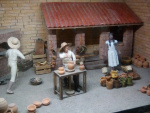

We then took a turn around the centro, which was very pleasant, and had some ice cream (another reference to the movie). There were a few nice statues, lots of benches to sit on, and a whole lotta shoe polishing carts. We admired La Casa de Visitas from our park bench.
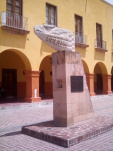


We hiked a few blocks to the Museo del Vino and the Casa de Hidalgo. Both had a $45 peso admission fee, which seemed a little steep now that we’d been to a few of the other museums. We opted not to tour either. I did peek in Hidalgo’s house and was reminded of another movie Hidalgo la Historia Jamás Contada which as far as historical movies go, wasn’t bad.
Of course, it could be that Hidalgo, who fathered children with two different women and spearheaded the national fight for Independence, was not quite what you would expect from a Catholic priest. Hidalgo had his own vineyards which were burnt in punishment for his treason against the crown, so the Museo de Vino wasn’t a far stretch of the imagination right there next to his house in what used to be a hospital. We did hit the gift shop and bought a locally produced bottle of wine called Lloro de Tierra. It was a nice, sweet, fruity rose and we enjoyed it immensely when we got home.
We did not get to the Museo de la Independencia, nor did we stop to see la Tumba de José Alfredo Jiménez en the Panteon. When we asked for directions to the cemetery, hoping it was close enough to walk to, we were told we’d have to walk “un chingo” to get there. My son’s flat feet were starting to ache and we were getting tired, so walking un chingo didn’t seem like something we were interested in doing.[image error] On the way out of the town, we stopped in another nice park with statues, a playground, some nice fountains (without any water) and benches that resembled sofas.[image error]As far as Pueblos Mágicos go, Dolores Hidalgo should be on your must-see list, not for the quality of the museums because they were rather ho-hum, but for the historical significance of the area, and the wine. I would recommend staying more than one day since there are so many things to see.
*************
[image error]



